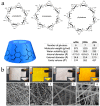Electrospun Food Polysaccharides Loaded with Bioactive Compounds: Fabrication, Release, and Applications
- PMID: 37242893
- PMCID: PMC10221597
- DOI: 10.3390/polym15102318
Electrospun Food Polysaccharides Loaded with Bioactive Compounds: Fabrication, Release, and Applications
Abstract
Food polysaccharides are well acclaimed in the field of delivery systems due to their natural safety, biocompatibility with the human body, and capability of incorporating/releasing various bioactive compounds. Electrospinning, a straightforward atomization technique that has been attracting researchers worldwide, is also versatile for coupling food polysaccharides and bioactive compounds. In this review, several popular food polysaccharides including starch, cyclodextrin, chitosan, alginate, and hyaluronic acid are selected to discuss their basic characteristics, electrospinning conditions, bioactive compound release characteristics, and more. Data revealed that the selected polysaccharides are capable of releasing bioactive compounds from as rapidly as 5 s to as prolonged as 15 days. In addition, a series of frequently studied physical/chemical/biomedical applications utilizing electrospun food polysaccharides with bioactive compounds are also selected and discussed. These promising applications include but are not limited to active packaging with 4-log reduction against E. coli, L. innocua, and S. aureus; removal of 95% of particulate matter (PM) 2.5 and volatile organic compounds (VOCs); heavy metal ion removal; increasing enzyme heat/pH stability; wound healing acceleration and enhanced blood coagulation, etc. The broad potentials of electrospun food polysaccharides loaded with bioactive compounds are demonstrated in this review.
Keywords: bioactive compounds; biodegradable polymers; controlled release; electrospun polysaccharide.
Conflict of interest statement
The authors declare no conflict of interest.
Figures










Similar articles
-
Polysaccharides as wall material for the encapsulation of essential oils by electrospun technique.Carbohydr Polym. 2021 Aug 1;265:118068. doi: 10.1016/j.carbpol.2021.118068. Epub 2021 Apr 12. Carbohydr Polym. 2021. PMID: 33966832 Review.
-
Polysaccharide Electrospun Nanofibers for Wound Healing Applications.Int J Nanomedicine. 2022 Sep 6;17:3913-3931. doi: 10.2147/IJN.S371900. eCollection 2022. Int J Nanomedicine. 2022. PMID: 36097445 Free PMC article. Review.
-
Polysaccharide-based nano-delivery systems for encapsulation, delivery, and pH-responsive release of bioactive ingredients.Crit Rev Food Sci Nutr. 2024;64(1):187-201. doi: 10.1080/10408398.2022.2105800. Epub 2022 Aug 5. Crit Rev Food Sci Nutr. 2024. PMID: 35930011 Review.
-
Latest Progress in Electrospun Nanofibers for Wound Healing Applications.ACS Appl Bio Mater. 2019 Mar 18;2(3):952-969. doi: 10.1021/acsabm.8b00637. Epub 2019 Feb 13. ACS Appl Bio Mater. 2019. PMID: 35021385
-
Chitosan-based electrospun nanofibers for encapsulating food bioactive ingredients: A review.Int J Biol Macromol. 2023 Aug 1;245:125424. doi: 10.1016/j.ijbiomac.2023.125424. Epub 2023 Jun 19. Int J Biol Macromol. 2023. PMID: 37343613 Review.
Cited by
-
Eco-Friendly and Smart Electrospun Food Packaging Films Based on Polyvinyl Alcohol and Sumac Extract: Physicochemical, Mechanical, Antibacterial, and Antioxidant Properties.Food Sci Nutr. 2025 Apr 22;13(4):e70190. doi: 10.1002/fsn3.70190. eCollection 2025 Apr. Food Sci Nutr. 2025. PMID: 40270940 Free PMC article.
-
Electrospun Quercetin-Loaded PLA and PLA/Polyethylene Glycol Fibers: Preparation, Characterization, and In Vitro Evaluation.Pharmaceutics. 2025 Apr 27;17(5):577. doi: 10.3390/pharmaceutics17050577. Pharmaceutics. 2025. PMID: 40430869 Free PMC article.
References
-
- Lv Q.-Z., Long J.-T., Gong Z.-F., Nong K.-Y., Liang X.-M., Qin T., Huang W., Yang L. Current State of Knowledge on the Antioxidant Effects and Mechanisms of Action of Polyphenolic Compounds. Nat. Prod. Commun. 2021;16:1934578X211027745. doi: 10.1177/1934578X211027745. - DOI
Publication types
Grants and funding
LinkOut - more resources
Full Text Sources

